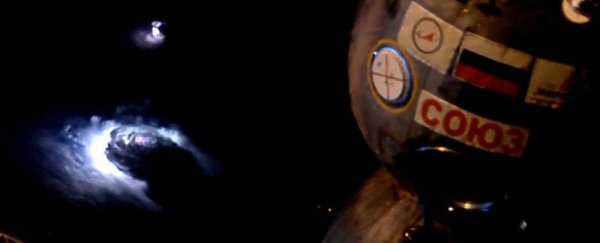Strange footage captured by Danish astronaut Andreas Mogensen while on board the International Space Station has revealed unexplained blue 'blobs', and extensive flashes of light piercing the dark expanse of space, while new images of bizarre upside-down lightning have been captured from the ground.
Presented at the European Geosciences Union meeting in Vienna last week, the incredible shots showcase the dynamic light show that occurs above a thunderstorm on Earth - elements of which no one has ever seen before.
Filmed from the cupola window of the International Space Station in 2015 during violent thunderstorms over India, Mexico, Thailand, and Costa Rica, the footage features rare columns of electrical discharge called blue jets that can fan up and out as far as 12 kilometres.
At this stage, no one quite knows how they form, but the best explanation we have right now is that when negatively-charged lightning hits the ground, it makes the clouds above more positively charged, and that creates just the right conditions for a blue jet to arise, Mika McKinnon explains over at Gizmodo.
"That electrical imbalance is released in skyward high-energising bursts that ionise nitrogen to produce a blue glow: a blue jet," she says. "The electrical ejections [move] fast, reaching speeds of 100 kilometres per second and dissipating within a quarter of a second. In the realtime video captured by Mogensen, it's far too easy to blink and miss the jet spearing out the top of the storm."
While blue jets have been known for some time, this the first time that anyone has witnessed the strange blue blobs that also appear in Mogensen's footage. Researchers have now named them 'glimpses', and they're now trying to figure out how they form.
"They were dancing over the top of the cloud, and we called them glimpses," Olivier Chanrion from the Danish National Space Institute told Andy Coghlan at New Scientist. "We sometimes saw around 100 glimpses per minute, and we think they're integrated between the top and bottom layers of the cloud. But it's only a first step and we need to find out more."

Not that outer space is the only place where weird shit happens during a thunderstorm - at last week's meeting, new images of upside-down lightning were also presented by the Danish National Space Institute team.
Shot from the ground by Rajesh Singh from the KSK Geomagnetic Research Laboratory in East India, the image reveals a bolt of lightning, up to 18 kilometres long, shooting into Earth's ionosphere - about 80 kilometres up into the atmosphere.
"They only last around 20 to 40 milliseconds," says Danish researcher, Torsten Neubert.
As New Scientist explains, a thunderstorm is a bit like a battery wedged between two conductors - Earth and the ionosphere. "Mostly, the battery shorts out by striking Earth, but it can also short out by striking upwards," says Neubert.
The researchers will be continuing their analysis of these strange phenomena, because they say we don't even know exactly how regular lightning occurs, let alone these upside-down, blue, and blobby versions.
It just might that the weirdness of outer space can teach us a whole lot about what's going on down here on Earth.
 Indian Institute of Geomagnetism
Indian Institute of Geomagnetism
